Body temperature - a complex indicator of the human body. Its types depend on a number of factors: age, health, time of day. Any deviations from the norm may indicate the development of pathologies of internal systems or organs.
Record content:
-
1 Types of temperatures in humans, their features
- 1.1 Low and low temperature
- 1.2 Normal
- 1.3 Subfebrile
- 1.4 Febrile
- 1.5 Pyretic
- 1.6 Hyperpyretic
- 1.7 Hypothermia
- 1.8 Hyperthermia
- 1.9 Fever
- 2 Human body temperature is normal
- 3 How to measure the temperature correctly
- 4 Temperature video
Types of temperatures in humans, their features
Types of human body temperature have a number of features. Any deviations from the norm may indicate the development of pathological processes inside the body.
The following factors affect the temperature:
- gender (sex) identity;
- the presence of pregnancy;
- well-being and health conditions;
- the impact on the human body of external factors.
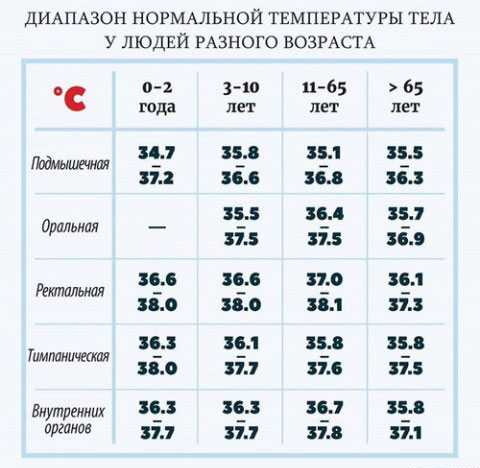
There are several main types of body temperature:
- low - less than 35 ° C;
- normal - 36... 37 ° С;
- subfebrile - 37... 38 ° C;
- febrile - 38... 39 ° C;
- pyretic - 39... 40 ° C;
- hyperpyretic - over 41 ° C.
Also, body temperature can be classified according to the state of health and well-being of a person. In hypothermia, the value usually does not exceed 35 ° C. The normal temperature is 35 ° C... 37 ° C. With hyperthermia, a temperature jump is observed up to 38 ° C and above. With fever, the body's thermoregulatory mechanisms are preserved, but the temperature is still elevated.
Low and low temperature
Temperature is considered an element of homeostasis. It is characterized by a circadian (circadian) regime. The temperature in different parts of the body can vary depending on the physiological processes in the body.
The main reason for the decrease in temperature can be considered a breakdown of thermoregulation, which occurred against the background of overvoltage.
If the temperature drops to 30-35 ° C, then there is a high risk of developing piloerection and muscle tremors. In a person with a reduced rate, sweating decreases, venous shunts open, blood is redistributed into deep veins. The volumetric velocity of cutaneous blood flow is reduced. Temperature fluctuations occur for a number of reasons. These include endogenous and exogenous factors.
Internal reasons for downgrading:
- old age, characterized by impaired heat transfer;
- traumatic brain injury (regardless of type);
- alcoholic, food, drug intoxication;
- rupture of internal blood vessels;
- pregnancy;
- insufficiency of the adrenal cortex;
- iron deficiency;
- prolonged lack of sleep, psycho-emotional overstrain, characterized by chronic fatigue;
- neurocirculatory dystonia or asthenic syndrome;
- hypothyroidism;
- state of immunodeficiency;
- improper nutrition.

Exogenous factors include hypothermia. During strong winds or high atmospheric humidity, a person feels chills.
The characteristic symptoms of a decrease in human body temperature include:
- lowering blood pressure;
- rapid, weak pulse;
- severe dizziness;
- increased sleepiness;
- slight lethargy;
- trembling, chills;
- discoloration of the skin;
- weakness, lethargy;
- loss of strength, malaise.
If a person's temperature has dropped, then breathing becomes shallow.
Normal
Types of human body temperature are characterized by a number of conditions. The value may vary depending on the age of the patient. The temperature is measured in the armpit.
Upper bounds:
- elderly people over 65 years old - 36.2 ° C;
- men and women up to 45 years old - 36.7 ° С;
- adolescents under 18 years old - 36.6 ° C;
- children from 3 to 6 years old - 37 ° С;
- children from 1 to 3 years old - 37.4 ° C;
- children under 6 months - 37.4 ° C;
- newborns - 36.7 ° C.
The values may differ depending on how the temperature is measured. If the deviation from the norm does not exceed 1-2 ° C, then there is no reason for concern. A slight increase may indicate a short-term malfunction of the regulatory system.
Subfebrile
Subfebrile condition occurs due to the negative impact of the irritant on the human body. The condition is difficult for children. Subfebrile temperature (no higher than 37.9-38 ° C) is also observed in adults. It can persist for a long time.

There are several main types of pathological conditions that are not associated with inflammation. Non-infectious fever occurs with brain injury, edema, or hemorrhage.
Also, the condition is observed against the background of neuroses and psycho-emotional overstrain. Subfebrile condition can occur with severe pain or against the background of prolonged use of antibiotics, xatin.
A febrile condition is most often of an infectious nature. In 70% of patients with low-grade fever, diseases accompanied by an inflammatory process are considered the cause of the deterioration in well-being.
Classification:
| Severity | Index |
| High | Up to 38 ° С |
| Low | 37.5... 37.9 ° C |
The hypothalamus is responsible for thermoregulation. Disruption of the activity of this part of the brain can provoke a long and persistent subfebrile condition.
The main reasons for the development of a pathological condition are considered diseases of a non-inflammatory and inflammatory nature.
The first category includes:
- psychogenic fever, which arose against the background of the patient's stay in a prolonged stressful situation;
- bronchial asthma;
- iron deficiency (chronic type anemia);
- asthenoneurotic syndrome;
- hyperthyroidism;
- premenstrual syndrome;
- hypothalamic syndrome;
- thermoneurosis;
- neurocirculatory dystonia.

Pathologies that can provoke an increase in temperature to subfebrile values:
- opportunistic infections associated with AIDS (including pneumocystis pneumonia);
- malignant and benign neoplasms (including acute leukemia, stomach cancer, hypernephroma and lymphoma);
- pathology of immune-inflammatory etiology (rheumatoid arthritis, ankylosing spondylitis, ulcerative nonspecific colitis, liver cirrhosis, chronic hepatitis, Crohn's disease);
- infectious mononucleosis;
- damage to the body by helminths (trichocephalosis, ascariasis, diphyllobothriasis);
- sexually transmitted diseases (including syphilis and gonorrhea);
- infections of a specific type (toxoplasmosis, brucellosis);
- respiratory diseases (including tuberculosis);
- diseases characterized by inflammation of the bladder, lungs, bronchi, gallbladder, sinuses, ears, teeth and tonsils.
In addition to an increase in temperature to subfebrile values, patients complain of rapid fatigue and weakness.

With fevers of infectious etiology, characteristic signs of poisoning appear:
- deterioration of health;
- refusal (partial or complete) from food;
- sleep disturbance;
- increased sweating (especially at night).
Disorders of the psycho-emotional background are observed: a person becomes irritable.
The symptom complex may vary depending on the disease:
- with ulcerative colitis, the temperature is accompanied by loose stools with mucus, blood and pus, severe pain in the epigastric region;
- with toxoplasmosis, the temperature is accompanied by irritability, headache, sleep disorders, weakness, spasms in the joints and muscles;
- with exacerbation of chronic pancreatitis, patients complain of stool disturbance, vomiting, nausea and bloating.


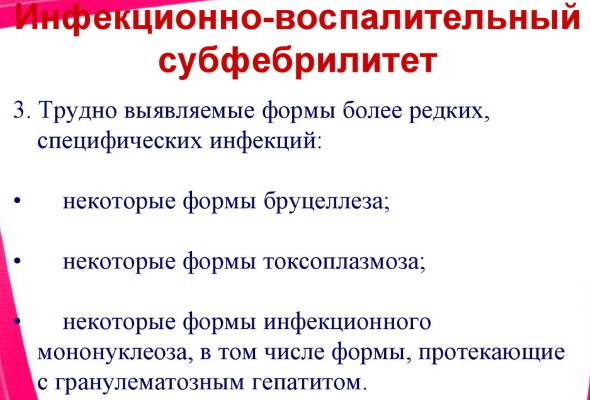
Subfebrile condition is also characteristic of lymphosarcoma, lymphocytic leukemia, sarcoidosis, systemic lupus erythematosus and sepsis.
Febrile
Types of human body temperature are an individual concept. Febrile body temperature is characterized by an increase in indicators up to 39 ° C. The patient's condition worsens, he may complain of rapid breathing, tachycardia, headache and fever.
The main reasons for the appearance of febrile temperature include:
- Colds. When viruses enter the human body, the temperature rises sharply. The prodromal period is usually short. After it, a fever sets in: a person feels a chill, followed by hyperemia. The eyes begin to shine, the vessels of the conjunctiva often burst. Febrile temperature can last up to 5 days.

- Infectious mononucleosis. The incubation period of the pathology is 7-10 days. The prodromal period is characterized by aching joints and bones, severe fatigue. If the patient has reduced immunity, then the indicators can reach 40-41 ° C. A person complains of difficulty swallowing and a sore throat. Lymph nodes may enlarge. Fever persists for 7-14 days.
- Diseases of a bacterial nature. Pathogenic microorganisms entering the systemic circulation accelerate the production of cytokines that negatively affect the hypothalamus.
Febrile temperature has a wave-like character (normal and elevated temperatures alternate). Diseases are accompanied by loss of appetite, exhaustion, impaired swallowing, breathing and outflow of urine (depending on the type of pathology).
- Acute abdomen syndrome. Against the background of the development of the inflammatory process in the abdominal cavity, the synthesis of pyrogens is accelerated. Substances of viral or bacterial origin quickly enter the bloodstream and slow down the process of thermoregulation.

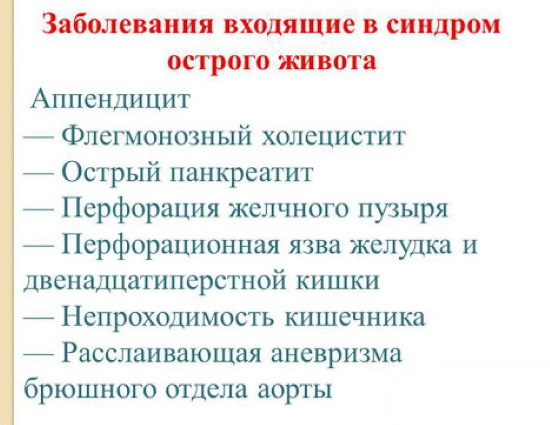
With an "acute abdomen", patients complain of tremors, chills and temperature fluctuations. Concomitant symptoms include various dyspeptic disorders (severe pain in the epigastric region, stool disturbances, attacks of nausea and vomiting).
- Diseases of a neurological nature. When the brain is damaged, the work of the hypothalamus is disrupted. In patients, the temperature rises to 40... 41 ° C. They complain of lingering headaches. The patient's condition worsens as the disease progresses. There are signs of encephalitis and purulent meningitis (drowsiness, hallucinations, delirium).
In children, the temperature rises to febrile levels during teething. Fever can be caused by antiepileptic drugs (carbamazepine, phenytoin) and psychostimulants (including cocaine and amphetamine).
Pyretic
Pyretic temperature is observed with the development of inflammatory processes in the body. Most often, the indicators vary in the range of 40... 40.9 ° C.
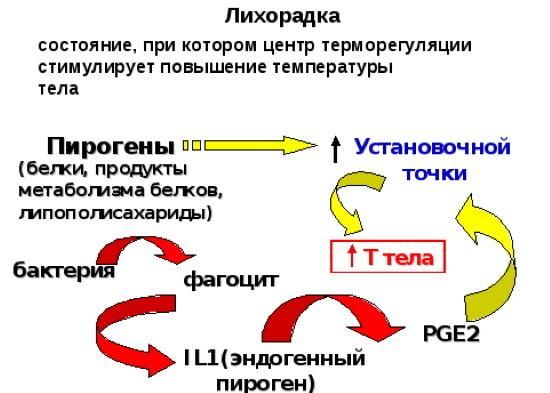
Pathologies of the inflammatory type develop against the background of the penetration of pathogenic bacteria and viruses into the body. Pyretic fever requires drug treatment: drugs are prescribed after examining the patient and identifying the cause of the development of hyperthermia.
These include:
- gastroenteritis;
- mononucleosis;
- meningitis;
- respiratory acute viral infections;
- flu.
Diseases of infectious etiology characterized by pyretic fever include:
- pharyngitis;
- tuberculosis;
- pneumonia;
- scarlet fever;
- chickenpox;
- measles;
- glomerulonephritis;
- pyelonephritis;
- candidiasis;
- gonorrhea;
- chlamydia;
- genital herpes;
- dysentery;
- malaria;
- anthrax;
- cholera;
- plague.
The main symptoms of pyretic fever include a rapid deterioration in well-being.
The patient often has characteristic signs of intoxication of the body: a person refuses food, his performance decreases, photophobia develops. The patient may complain of pain in muscles, bones and joints. Fever is also accompanied by increased heart rate and increased breathing. The risk of developing vomiting and nausea is high.
Hyperpyretic
Types of human body temperature include the hyperpyretic type. Thermoregulatory disorders are characterized by malaise, muscle pain, and migraine. It usually occurs in diseases of infectious and viral etiology. At a hyperpyretic temperature, the indicators rise to 41 ° C.
The main reasons for its development include:
- exacerbation of pathologies of the chronic course;
- diseases of a viral nature (ARVI, influenza);
- autoimmune pathologies;
- post-viral asthenia;
- development of inflammatory processes and edema;
- psychoemotional disorders;
- the growth of malignant and benign neoplasms;
- respiratory pathology;
- disorders of the functional activity of the thyroid gland;
- fever caused by medication;
- toxoplasmosis;
- viral hepatitis;
- pathology of the urinary and circulatory system;
- abscess and necrosis of tissues, internal organs;
- diseases of a venereal nature;
- infections that develop in the body during the rehabilitation period after surgery.
Hyperpyretic body temperature is a rather life-threatening condition for the patient. Most often, it indicates intracranial hemorrhage or sepsis. Hyperpyrexia in children indicates enterovirus or measles. Concomitant symptoms include delirium, fever, and vascular spasms.
Hypothermia
Hypothermia is characterized by a decrease in temperature indicators to 35 ° C and below.
The main causes of the pathological condition are considered:
- general or regional anesthesia;
- prolonged exposure to water or a cold room;
- intravenous administration of blood products or cold solutions.
At risk are:
- people who systematically abuse alcohol;
- children;
- elderly patients;
- immobilized (due to trauma, circulatory disorders in the brain) or unconscious people.

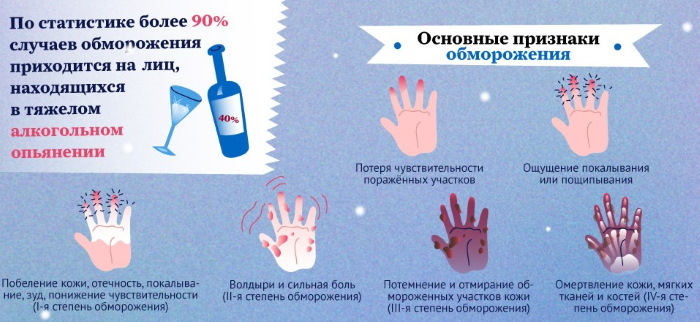
Pathological hypothermia usually occurs with hypothermia. Therapeutic (artificial) temperature reduction is used to prevent ischemic damage to soft tissues due to impaired circulation.
The main indications for use are:
- cardiac arrest;
- fever of a neurogenic type, which has arisen against the background of brain injuries;
- damage to the central nervous system;
- stroke;
- hypoxia in newborns.
Hypothermia can be conditionally divided into several types:
- heavy - 27 ° C and below;
- average - 32... 27 ° С;
- light - 36... 32 ° С.
In severe hypothermia, the patient's body loses its ability to passively and independently warm up.

The characteristic signs of a decrease in temperature indicators include:
- increased heart rate;
- breathing disorder;
- involuntary muscle contractions;
- apathy;
- disorientation in space and time;
- increased sleepiness.
Blood glucose levels rise during hypothermia. The risk of vascular spasms is high.
The most common symptoms in patients with severe hypothermia include:
- atrial fibrillation;
- bradycardia;
- asthma attacks occurring against the background of a decrease in the frequency of respiratory movement;
- lowering blood pressure;
- polyuria;
- lack of response to light and other stimuli;
- lack of tendon and articular reflexes.
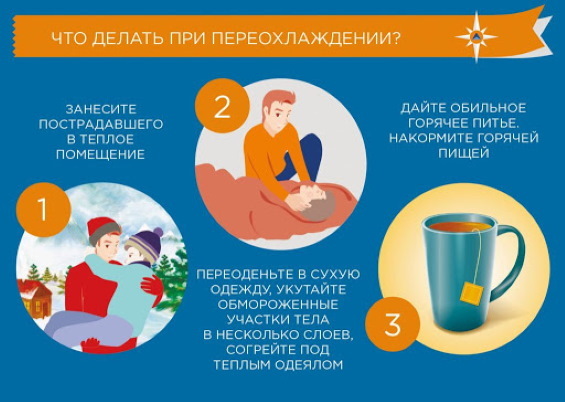
In severe hypothermia, the patient may fall into a coma.
Hyperthermia
Hyperthermia occurs against the background of disruptions of thermoregulatory mechanisms. With an increase in temperature indicators, large and small blood vessels expand, a person's breathing quickens, sweat begins to evaporate faster.
The endogenous causes of the development of hyperthermia include:
- long-term use of adrenergic agonists and anticholinergics;
- violation of the processes of phosphorylation and oxidation in mitochondria;
- an increase in heat production caused by tonic tension of muscle fibers that occurs during intoxication or tetanus;
- acceleration of metabolism in diseases of the pituitary gland, adrenal glands or thyroid gland;
- stimulation of cortical centers, which has arisen against the background of mental illness, hysterical reactions or various psychotraumatic factors.
- long-term use of drugs that stimulate metabolism;
- damage to the thermoregulatory centers located in the brain (against the background of thromboembolism, disruption of the central nervous system, traumatic brain injury or hemorrhage).
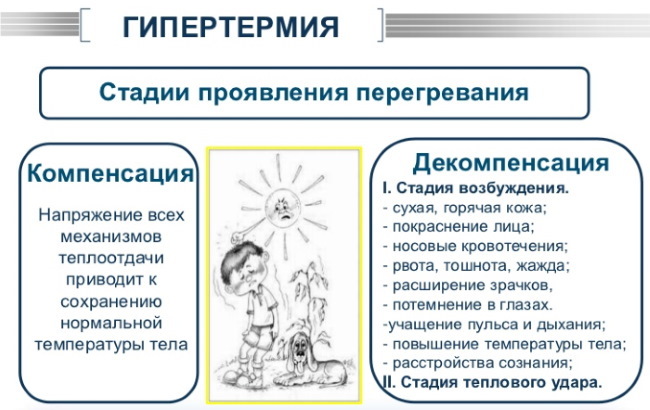
Exogenous reasons for the development of hyperthermia include:
- prolonged stay in a poorly ventilated room;
- wearing clothes that impede heat transfer;
- stay in the bath, sauna for a long time.
In addition to an increase in temperature indicators to a critical level, hyperthermia is accompanied by the following symptoms:
- hearing loss;
- confusion, convulsions, delirium, hallucinations;
- short-term amnesia;
- wobbly gait;
- "Hot flashes", "ebb", hyperemia;
- nausea, vomiting;
- dizziness, "flies" before the eyes, migraine;
- increased heart rate;
- increased sweating.
With hyperthermia, the skin becomes pale or, conversely, pink (depending on the nature of external manifestations).
Fever
Types of body temperature, as an indicator of a person's condition, are considered biomarkers. Fever, as a clinical syndrome, occurs against the background of the penetration of viruses and bacteria into the human body.
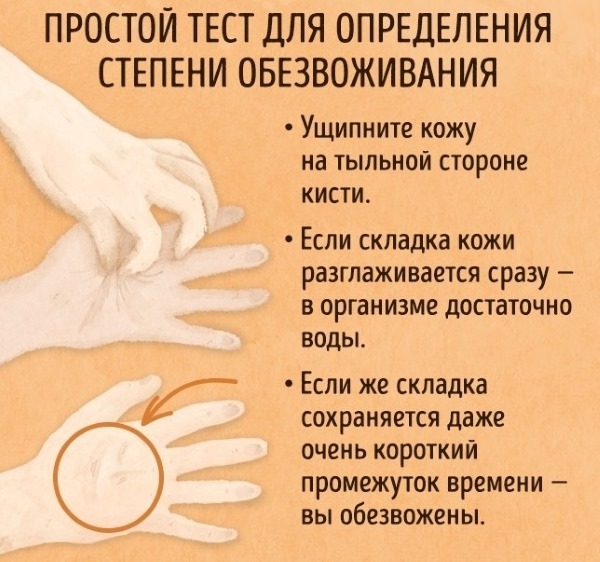
The causes of occurrence also include:
- dehydration;
- thermal shock;
- mechanical injury.
Sometimes a fever can be caused by an intoxication of the body.
It also develops against the background of a number of pathologies:
- lymphoma;
- myocardial infarction;
- rheumatoid arthritis;
- kidney disease;
- toxicosis.
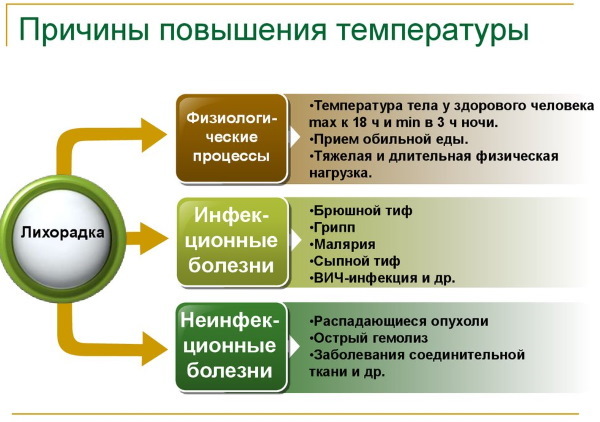
The characteristic symptoms of a febrile state include:
- hyperemia;
- headache;
- aching bones;
- thirst;
- chills;
- shiver;
- increased sweating;
- loss of appetite;
- confusion of consciousness;
- rave.
The patient becomes irritable. The condition is extremely dangerous: with fever, in addition to an increase in temperature, encephalitic, hemorrhagic and meningeal syndrome may occur. The risk of developing neurotoxicosis is high.
Human body temperature is normal
Temperature readings may vary depending on gender, age and condition of the patient:
| Patient category | Indicators |
| Newborn | 36.3 ° C |
| Children (up to 14 years old) | 36.1... 36.6 ° C |
| Teenagers (14-18 years old) | 36.6... 36.8 ° C |
| Adult women (18-45 years old) | 35... 37 ° C |
| Adult men (18-45 years old) | 36... 37 ° C |
| Elderly men (over 65) | 36... 37.3 ° C |
| Older women (over 65) | 35... 37.4 ° C |
| Pregnant women | 36.5... 37.2 ° C |
During menopause, there may be a slight increase in temperature indicators by 1-1.5 units. (up to 37-37.5 ° C).
How to measure the temperature correctly
You can measure the temperature with a thermometer. This is a fairly accurate method (slight fluctuations of 0.1 ° C are possible). Digital thermometers are also very popular - these small electronic devices instantly measure the temperature.
Non-contact infrared thermometers are also available on the market. Temperatures can be measured in the armpit, mouth, or rectum. Experts recommend measuring indicators in the morning (7.00-8.00) and in the evening (17.00-21.00).

If a person uses a mercury thermometer for measurement, then it must be shaken before use. With the metal end, a thermometer or digital device is placed in the armpit and pressed by hand for 5-10 minutes.
If the temperature is measured in the oral cavity or rectum, then thoroughly disinfect the thermometer before use. The device is placed in the rectum for 3-5 minutes, in the oral cavity - for 60-90 seconds.
After the procedure, you can place the thermometer in a chloramine solution (2%) for 5 minutes. The device must be stored in a plastic tube. The above methods are considered the most accurate.
Types of body temperature, as complex indicators of thermoregulation, are biomarkers. In most cases, a person with the development of subfebrile condition or febrile condition complains of a deterioration in well-being. The high temperature can only be brought down with medication.
Temperature video
Types of human body temperature:



